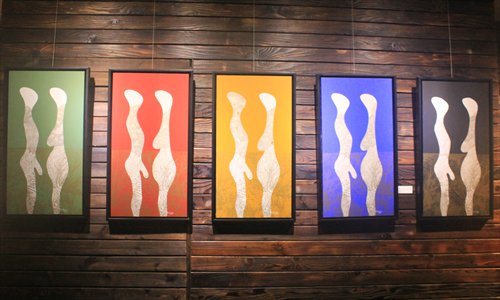

Growth by Karma Dorje Tsering. (Photo: Xu Ming/GT)
Tibetan artist represents traditional culture through new means
Dazzling colors, random but delicate lines, mystical images and a heavy touch of Tibetan culture; walking around the exhibition of Tibetan artist Karma Dorje Tsering's works is like traveling in a fantastic world of unrestrained imagination.
Kicked off on Sunday, Elements - The Visible and Invisible, an exhibition of Karma's works on display at the Baimamedo Art Center in Beijing, provides a great opportunity for people get to know more about this artist and his works and how traditional Tibetan culture is finding new life in modern paintings.
Universal concern
Boasting over 60 of Karma's paintings that he created between 2006 and 2014, the exhibition acts as a summary of his creative style during this eight year period.
It's extremely difficult to define these paintings. Splicing big patches of colors makes these acrylic works appear like oil paintings, while fine delicate linework make them also seem like etchings. Add in the mystical imagery and they also resemble traditional Tibetan murals.
In the end, his works are a combination of several kinds of painting styles that blend with each other harmoniously, a perfect mixture of tradition and modernity, worldliness and spirituality.
Within the artwork on display at the exhibition, Karma has generalized elements of Tibetan culture and religion representing them on a philosophical level that shows his compassion and concern for all forms of life and the space they live in.
For example, in the series of five paintings titled Growth, he uses symbols to represent the yin and yang of Chinese philosophy, the interactions of which gives birth to everything. Additionally, each painting is painted with a different color representing one of the wu xing, or Five Agents - Wood, Fire, Earth, Metal, Water - that represent the cycle of change that all things on earth undergo.
Meanwhile over in another series of paintings titled Himalayas, the mountains are depicted in a way that they also resemble the shape of human beings, a deliberate choice the artist made to explore the interdependent relationship between humanity and nature.
"I am attempting to reflect on how human beings' demands on nature have caused damage to the environment and the pressure of maintaining sustainable development," he explained.
Another painting, Deep Sea, features a large blue space circled by living organisms. "Billions of years ago, the Tibetan Plateau was deep below the sea. I want to show the circle of life and the power of The Mother through this painting."
"Karma's works point to the essence of philosophy and the universe. They are able to provide enlightenment to viewers," commented artist and writer Cai Jinsong during the exhibition's opening ceremony.
Copyright ©1999-2018
Chinanews.com. All rights reserved.
Reproduction in whole or in part without permission is prohibited.